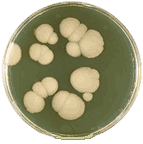Papers in the Biological Sciences
Date of this Version
2015
Document Type
Article
Citation
Water Res. 2015 February 1; 69: 110–119. doi:10.1016/j.watres.2014.11.016.
Abstract
Despite the low nutrient level and constant presence of secondary disinfectants, bacterial re-growth still occurs in drinking water distribution systems. The molecular mechanisms that starved bacteria use to survive low-level chlorine-based disinfectants are not well understood. The objective of this study is to investigate these molecular mechanisms at the protein level that prepare starved cells for disinfection tolerance. Two commonly used secondary disinfectants chlorine and monochloramine, both at 1 mg/L, were used in this study. The proteomes of normal and starved Escherichia coli (K12 MG1655) cells were studied using quantitative proteomics. Over 60-min disinfection, starved cells showed significantly higher disinfection tolerance than normal cells based on the inactivation curves for both chlorine and monochloramine. Proteomic analyses suggest that starvation may prepare cells for the oxidative stress that chlorine-based disinfection will cause by affecting glutathione metabolism. In addition, proteins involved in stress regulation and stress responses were among the ones up-regulated under both starvation and chlorine/monochloramine disinfection. By comparing the fold changes under different conditions, it is suggested that starvation prepares E. coli for disinfection tolerance by increasing the expression of enzymes that can help cells survive chlorine/monochloramine disinfection. Protein co-expression analyses show that proteins in glycolysis and pentose phosphate pathway that were up-regulated under starvation are also involved in disinfection tolerance. Finally, the production and detoxification of methylglyoxal may be involved in the chlorine-based disinfection and cell defense mechanisms.
Included in
Environmental Microbiology and Microbial Ecology Commons, Other Life Sciences Commons, Pathogenic Microbiology Commons



Comments
Copyright © 2014 Elsevier Ltd. Used by permission.